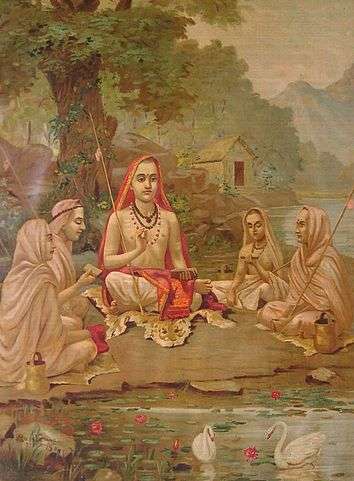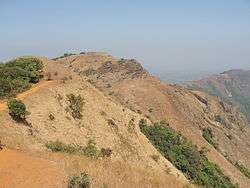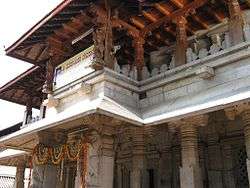Kollur, Udupi district
| Kollur ಕೊಲ್ಲೂರು Kolluru | |
|---|---|
| village | |
|
Sri Kollur Mookambika Temple | |
 Kollur  Kollur Location in Karnataka, India | |
| Coordinates: 13°41′56″N 74°48′42″E / 13.69889°N 74.81167°ECoordinates: 13°41′56″N 74°48′42″E / 13.69889°N 74.81167°E | |
| Country |
|
| State | Karnataka |
| District | Udupi |
| Taluk | Kundapur Taluk |
| Elevation | 568 m (1,864 ft) |
| Languages | |
| • Official | Kannada |
| Time zone | IST (UTC+5:30) |
| PIN | 576220 |
| Telephone code | 08254 |
| Vehicle registration | KA-20 |
| Website |
www |

Kolluru or Kollur (Kannada:ಕೊಲ್ಲೂರು) is a small temple-town in Kundapur Taluk in Udupi district of Karnataka state, India. It is situated about 38 km from Kundapur town. This village lies at the foot of the Western Ghats and is famous for the Mookambika temple, a Hindu pilgrim center.
Kollur also called Kollapura one of the important places of pilgrimage in Karnataka State, which has a temple dedicated to Mookambika.
The goddess is called Mookambika as she is said to have slain the demon Mookasura. The goddess is described as in the form of a jyotirlinga incorporating both Shiva and Shakti. The panchaloha image of the goddess on Shri Chakra is stated to have been consecrated by Shri Adi Shankaracharya. The Divine Mother is said to be a manifestation of trigunas or triple forms. The shikhara of the temple which is well gilded with gold is said to have been donated by Sankanna Savantha. Around the chief shrine of Mookambika, there are many other shrines.
The idol of Chandramaulishvara is said to have been installed by Shri Adi Shankara. The temple has been renovated by Keladi rulers. The temple of Mookambika and other shrines attract a large number of pilgrims from other states too.[1]
Myths and legends
Kollur is an important seat of Shakti worship. The temple is rich in puranic lore.
Legend goes that a Maharishi (monk) Kola was enchanted with nature’s beauty and decided to perform a penance on a rock near the Agnitheertham. Lord Shiva, delighted with Kola, appeared before him and blessed him. The Maharishi wished for the welfare of mankind and nothing else. The Lord, happy with Kola, granted him his wish. He assured that a swayambu (autogenetic) Linga would appear for his daily worship. However, Kola wanted to worship Devi also. So, a swarna rekha (gold line) appeared on the Lingam, signifying Shakti. Thus, Shiva and Shakti are worshipped together in the Lingam. Besides this, a unique feature is that the other Gods and Goddess of the Hindu pantheon also believed to reside in aroopa (non-form) in the Linga. It is thus believed to be an abode of the entire celestial congregation. It is believed that Adi Shankaracharya had a vision of Sri Mookambika Devi and installed the deity here. The legend goes that Adi Shankara meditated at Kodachadri hills and Devi incarnated before him asking for his wish. He revealed his wish to install the Devi idol in a place in Kerala to worship where he wanted. Devi agreed but put forward a challenge that she will follow Shankara and he should not look back till he reaches his destination. But to test Shankara, Devi deliberately stopped the voice of her anklets when they reached Kollur whereupon Shankara turned and looked back because of doubt. Devi then asked Shankara to install her vigraha, just as he sees her, at that very location in Kollur. Another legend says that original temple is at Kodachadri peak,(1343 mt) which is at a distance of about 20 km from Kollur, also visible as a large mountain peak in front of the temple. There also a small temple dedicated to Mookambika near Kodachadri peak.
Main Temple of Mookambika
- Shri Mookambika Devi Temple
- Kollur is believed to be one of the seven pilgrim centres created by Parashurama, a Hindu mythological figure. The temple is devoted to the Hindu goddess Parvathi, wife of Shiva. While the other pilgrimages created by Parashurama are devoted to Lord Shiva, Lord Subramanya and Lord Ganesha, this one is devoted to goddess Parvathi. The temple is constructed on the banks of a tributary of Souparnika River and in the middle of a forest. Just in front of the temple, Kodachadri peak and mountain is visible, which is a delightful sight. It is believed that original temple is on top of Kodachadri peak, and to make it convenient for devotees to offer pooja, the temple is constructed at Kollur. Devotees from all over South India visit this temple. Many pilgrims from Kerala visit the temple and perform vidyaarambham during Vijayadasami here.
Around Kollur
- Kashi Theertha is a beautiful river spot with a bridge and forest trekking opportunities about 1 km from the Mookambika temple.
- Souparnika is a river spot where devotees take a holy dip. This tourist spot has parking facilities, toilet and a small tea shop. This spot is about 1 km from Mookambika temple.
- Anegudde Vinayaka Temple
- One of famous temple of Udupi District. Located southern side of Kundapur on NH66 (From Kundapur Bus-stand 7 km and Kundpur Station ~10 km). God Siddhi Vinayaka or Sarva Siddhi Pradaayaka will grant and fulfill his devotees’ wishes. People believe in him that he will solve their problems. The garba griha or the main sanctum has the Lord Vinayaka in Chaturbuja (with 4 arms) in huge rock like structure covered in silver armour. Two arms are posing as “Varada Hasta” granting boons, and two hands indicate to attain salvation. There are many sculptures related to Bhargava Purana.
 Path leading to Sarvajna Peeta,Kodachadri,India
Path leading to Sarvajna Peeta,Kodachadri,India
- One of famous temple of Udupi District. Located southern side of Kundapur on NH66 (From Kundapur Bus-stand 7 km and Kundpur Station ~10 km). God Siddhi Vinayaka or Sarva Siddhi Pradaayaka will grant and fulfill his devotees’ wishes. People believe in him that he will solve their problems. The garba griha or the main sanctum has the Lord Vinayaka in Chaturbuja (with 4 arms) in huge rock like structure covered in silver armour. Two arms are posing as “Varada Hasta” granting boons, and two hands indicate to attain salvation. There are many sculptures related to Bhargava Purana.

- Arishna Gundi Waterfalls
- A scenic waterfall inside the deep jungle only approachable by trekking. Due to the special effect of the sun's rays falling on the water droplets around the waterfall, it looks orange-yellow in colour and so the name is "Arishna" (Turmeric/Yellow).
- Kodachadri Mountain in the Western Ghats
- Adi Sri Shakthi Mookambika Temple is on the top of the mountain believed to be the real abode of Devi from where Adi Shankara re-established it at the foothills at Kollur.
- Mookambika Wildlife Sanctuary is aided by the World Wildlife Fund. This sanctuary is home to an endangered species called the Lion tailed monkey.
- Spread along the Kundapur-Kollur-Shimoga road, this sanctuary is generally off the tourist map.
- Maravanthe beach, where sea and river come very close, but to leave a National Highway (17) in between is a rare sight; this beach is between Kundapur and Kollur,on the way to Kollur.
- Sigandur is a forest village known for the temple of Goddess Chaudeshwari. It is situated at a distance of 45 km from Kollur, on the way to Shimoga, a diversion from Kollur-Shimoga Road at Nagodi.It is in Sagara Taluk.
- Jog Falls India's second-highest plunge waterfall in India is about 2 hours drive from Kollur.It is in Sagara Taluk.
See also
- Mookambika temple
- Mahasati Temple, Sodigadde
- Basrur
- Maravanthe
- Udupi
- Mangalore
References
- ↑ Kamath, Suryanath, ed. (1983). Karnataka State Gazetteer. 2: 1261 http://gazetteer.kar.nic.in/. Retrieved 10 September 2011. Missing or empty
|title=(help)
External links
| Wikimedia Commons has media related to Kollur. |
